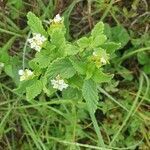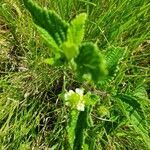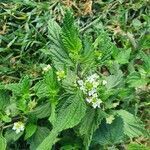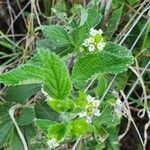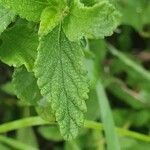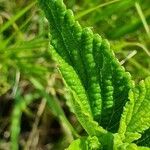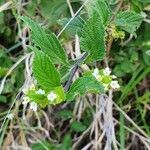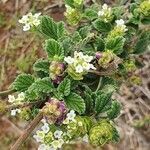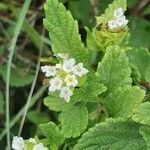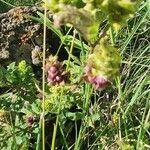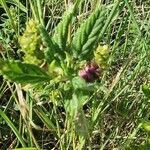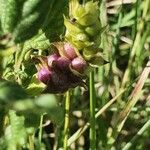Spikes 1–3(4) per axil, shorter than the subtending leaf, 3–8.5(10) × 3–4 mm, subspherical or ovoid, sometimes subcylindric in flower, up to 19 × 7 mm and ovoid-oblong to cylindric in fruit, purple or dull-reddish, ± dark brownish on drying; peduncles 0.6–3 cm long, equal or unequal in length, usually erect, slender, with an indumentum similar to that of the branches; bracts imbricate, sparsely to densely spreading white pubescent or silky, glandular, 2–3 × 1.75–2 mm, broadly ovate or obovate, accrescent and up to c. 3.75 mm broad in fruit, abruptly and shortly apiculate to long acuminate, the lower bracts deeply concave and truncate to shortly cuneate at the base, progressively smaller and less concave upwards, appressed not spreading or reflexed.
Much-branched shrub, 0.7-5.0 m high; many-stemmed, stems erect, striate; hairs tubercle-based, appressed or spreading, short, stiff, glands small. Leaves petiolate; opposite or 3-whorled; lanceolate to obovate, 10-100 x 3-43 mm, base rounded then cuneate, apex subacute or obtuse, margins crenate-serrate, papyraceous; strongly rugose and scabrid above, softly and densely velvety below. Inflorescence: spikes 1-5 per axil, conical or oblong. Flowers white, creamy white, throat yellow. Calyx 2-lobed, ovate-campanulate. Corolla: tube narrowly funnel-shaped from narrow base; limb 2-lipped. Flowering time Sept.-Apr. Fruit of half-ovoid nutlets (mericarps), smooth.
Leaves opposite-decussate, shortly petiolate; lamina 2–9.5(13.5) × 0.8–3.2(5) cm, lanceolate, oblong-lanceolate or elliptic or sometimes obovate, subacute or obtuse at the apex, rounded then cuneate at the base, crenate-serrate or closely serrulate on the margins except near the leaf base, papyraceous, the upper surface dull green, strongly rugose and scabrid above with tubercle-based hairs, the lower surface pale or grey-green, softly and densely often ± velvety appressed pubescent with small glands, the nerves ± prominent, lateral nerves 4–7(10) on each side, ascending, impressed above and prominent beneath.
Corolla white or creamy-white, yellow in the throat, glandular and pubescent outside in the upper half, 2–3 mm long, caducous; tube narrowly funnel-shaped from a very narrow base, 1–1.5 mm in diameter at the throat; limb ± 2-lipped with the posterior lip entire and the anterior one 3-lobed, the median lobe larger than the lateral ones.
Stems usually erect, subterete or somewhat angular, green, soon turning brown, striate, the stems and branches rather leafy with inflorescences in nearly all axils, ± densely hispidulous with appressed or spreading short stiff tubercle-based whitish hairs and small glands.
A shrub. It has many branches. It grows 4.5 m tall. The leaves are opposite. They are sword shape with rounded teeth along the edge. The leaves have a smell. The flowers are white and in dense round heads. They are in the axils of leaves. The fruit are small and dry.
Calyx 2-lobed, half as long as the corolla, 1–1.25 mm broad, ovate-campanulate, compressed in anterior-posterior plane, slender, membranaceous, pale yellow-green, usually densely spreading pubescent to silky outside, somewhat accrescent in fruit, persistent.
Shrub, 0.7-5.0 m high. Bracts less than 4 mm long and 3 mm wide, not exceeding flowers. Calyx distinctly 2-lobed. Flowers white, greenish white, cream, yellowish white or yellow.
Perennial herb or shrub 1–2 m (3 m or more?) high, much branched often from the base or many-stemmed, leaves strongly aromatic when crushed.
Mericarps brown on the convex face, white on the flat commissural face, 1.5–1.75 × 1–1.25 mm, half-ovoid or sub-hemispheric, glabrous.
Anthers sulphur-yellow.
